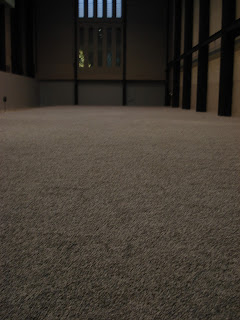Does anybody else ever need to revamp the look of their blog simply so they can write a post after a long hiatus?
Or am I alone in this great big world?
Either way, I (or rather, my blog) is revamped and I can finally get around to actually writing something on this thing.
I haven't checked the date of my last post but I'm sure it's safe to say it's been far too long.
A lot has happened. Recap?
1. Mark and I moved to Ireland.
Yep. That sums it up.
So this first post back isn't going to be about this amazing country, what we've done since arriving or what the name of my favorite pub is (Tigh Neachtain's). This post, true to form, is going to be about art.
I came across two pieces recently. One IRL (in real life for all you internet-lingo-losers out there. Us winners call you the ILLs.) and one at a URL. Gosh I'm so clever with my abbreviations tonight!
The first:
Ai Weiwei's Sunflower Seeds has to be one of the coolest artworks I've come across in a long while. In the main turbine hall of the Tate Modern, over 100 million sunflower seeds were placed on the floor. And you're probably thinking...what a waste of food (At least that's where my ravenous mind/tummy goes)! BUT these sunflower seeds are not real sunflower seeds. Each seed in an individually made, hand painted piece of porcelain! Crazy right? CRAZY.
I loved this piece not just for the sheer magnitude or because I had the urge to steal one of these seeds and risk being banned from the Tate Modern forever, but because the emphasis on the piece was on the process, on the work that went into it. There was a video that accompanied this work that they showed in a small enclosure nearby and watching the process of the piece was fascinating. Ai Weiwei basically supported people in a small Chinese town that would normally be unemployed and penniless by creating this artwork. Art for the greater good? I'm sold.
A similar art piece that I came across online was this:
Meet Motoi Yamamoto and his labyrinths. He creates these works with salt--2,200 pounds of salt to be exact--and a helluva lot of patience. Now, different from Weiwei--who has had others involved throughout the whole process of Sunflower Seeds--Yamamoto creates the piece but then lets others change the maze or disrupt the maze if they so choose. (Sidenote: Tate Modern visitors used to be able to walk on the sunflower seeds but then they realized the dust from the porcelain could be hazardous. Also, a friend told me that they were practically sweeping it all back in place all the time--which to me would have been a major detraction. While it would have been cool to walk on them--and I would have been able to steal one easier that way--I'm glad it was the way it was by the time I got to it.)
Again, what is so amazing about these pieces is the sheer undertaking of the work itself--the process. However, they are also remarkable (in my opinion) because both men intentionally chose mediums and and processes that have significant meanings for their respective cultures and societies. Let me break it down for you:
Weiwei. Chinese. Mao. Mao as the Sun. Therefore, all Chinese people are sunflowers. Sunflower seeds as metaphor. Get it? It's explained better here.
Yamamoto. Japanese. Traditional symbol for purification and mourning in Japan: Salt. Mazes=eternity. There is a more personal reason behind the need to make mazes with salt. Curious what it is? Thought so. That's why I gave you the link earlier silly gooses!
Both Weiwei and Yamamoto's undertakings were extreme and massive, to say the least. But what they accomplish by working in such exaggerated numbers is a general sense of awe in the viewer. And what's even more impressive is that the awe is not limited to their visual effect. The awe is perpetuated by the process and the story behind the purpose of these pieces and what they represent.
Bottom line: Asians dominate.









No comments:
Post a Comment